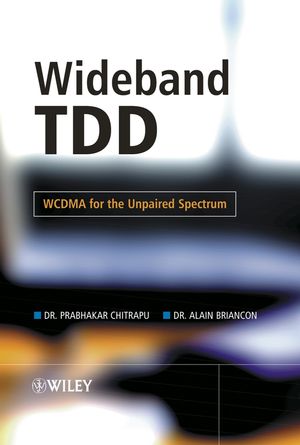Wideband TDD: WCDMA for the Unpaired SpectrumISBN: 978-0-470-86104-2
Hardcover
296 pages
May 2004
 |
||||||
List of Figures xiii
List of Tables xix
Preface xxi
Acknowledgements xxiii
Foreword xxv
Acronyms xxix
1 Introduction 1
1.1 WTDD Technology 2
1.2 Other Advanced Radio Interface Technologies 2
1.3 3GPP Standards for Wideband TDD (WTDD) 3
1.4 Overview of the Book 4
2 System Architecture and Services 5
2.1 UMTS System Architecture 5
2.1.1 CN Architecture 5
2.1.2 UTRAN Architecture 7
2.1.3 Radio Interface 10
2.2 Protocol Architecture 10
2.2.1 UMTS Protocol Layers 11
2.2.2 Protocol Models for UTRAN Interfaces 12
2.3 UMTS Services 15
2.3.1 Traffic Classes and Quality of Service 16
2.3.2 UMTS QoS Attributes 18
References 19
3 Fundamentals of TDD-WCDMA 21
3.1 TDD Aspects 21
3.2 TDMA Aspects 22
3.2.1 Data Burst Structure 22
3.2.2 Midamble Generation 23
3.2.3 Synchronization Bursts 25
3.3 WCDMA Aspects 26
3.3.1 Spreading and Modulation 26
3.4 Modem Transmitter 28
3.4.1 Error Protection 29
3.4.2 Interleaving and Rate Matching 31
3.4.3 WCDMA and TDMA Processing 32
3.4.4 Pulse Shaping and Up Conversion 32
3.4.5 RF Characteristics 32
3.4.6 Transmit Diversity 34
3.5 Mobile Radio Channel Aspects 36
3.5.1 Mean Pathloss and Shadow Characteristics 36
3.5.2 Multipath Characteristics 37
3.6 Modem Receiver Aspects 38
3.6.1 RF Characteristics 38
3.6.2 Detection of Direct Sequence Spread Spectrum Signals 39
3.6.3 Rake Receiver Structure 39
3.6.4 Joint Detection Receiver Structure 41
References 42
4 TDD Radio Interface 43
4.1 Overview 43
4.2 Protocol Architecture 45
4.3 Layer 1 Structure 48
4.3.1 Physical Channels 48
4.3.2 Transport Channels 55
4.4 Layer 1 Communication 59
4.4.1 Layer 1 Processing 59
4.4.2 Inter-Layer Communication 61
4.5 Layer 2 Structure 63
4.5.1 Logical Channels 63
4.5.2 Radio Bearers 64
4.6 Layer 2 Communication 65
4.6.1 Medium Access Control (MAC) Protocol 65
4.6.2 Radio Link Control (RLC) Protocol 71
4.6.3 Packet Data Protocols (PDCP) 77
4.6.4 BMC Protocol 79
4.7 Layer 3 Communication 81
4.7.1 Radio Resource Control (RRC) Protocol 81
Appendix 4.1 System Information Blocks 85
References 86
5 TDD Procedures 89
5.1 Introductory Concepts 89
5.1.1 RRC Modes and States 89
5.1.2 DRX/Sleep Mode 90
5.2 Overview of Procedures 93
5.3 PLMN/Cell Selection/Reselection Procedure 95
5.4 Random Access Procedure 97
5.5 Paging Procedures 99
5.5.1 Paging Types 99
5.5.2 Paging Process at Layer 2 and Above 100
5.5.3 Broadcast Paging 101
5.5.4 Paging at Layer 1 103
5.5.5 Dedicated Paging Example 104
5.6 RRC Connection Procedures 104
5.6.1 Procedure between Network Elements 104
5.6.2 Procedure between Protocol Entities 105
5.7 RAB/RB Establishment Procedures 106
5.8 RAB/RB Management Procedures 110
5.9 Power Control Procedures 114
5.10 UE Timing Advance Procedures 119
5.10.1 Initial Timing Advance 120
5.10.2 Steady-State Timing Advance 121
5.11 Measurements Procedures 122
5.11.1 Common UE Measurements 123
5.11.2 Specific UE Measurements 123
5.11.3 Measurement Types 123
5.11.4 Measurement Reporting Methods 125
5.11.5 Node B Measurements 127
5.12 Cell/URA Update Procedures 127
5.13 Handover Procedures 130
5.14 NAS Signaling Message Transmission Procedures 135
5.15 Data Transmission Initialization Procedures 136
5.15.1 Inter-Layer Procedure 138
5.16 End-to-End Communication Procedures 139
5.16.1 UE Registration Procedures 139
5.16.2 Authentication and Security 142
5.16.3 CS Call Control Procedures 143
5.16.4 PS Session Control Procedures 146
5.16.5 CS Call and PS Session Data Procedures 147
References 149
6 Receiver Signal Processing 151
6.1 Receiver Architecture 151
6.2 Channel Estimation 154
6.2.1 Post-processing 157
6.3 Data Detection 157
6.3.1 Introduction 157
6.3.2 Multi-User Detection 159
6.3.3 Zero-Forcing Block Linear Equalizer (ZF-BLE) JD 160
6.3.4 Minimum Mean Square Error Block Linear Equalizer (MMSE-BLE) Joint Detector 161
6.3.5 Zero Forcing Block Linear Equalizer with Decision Feedback (DF ZF-BLE) Joint Detector 161
6.3.6 Minimum Mean Square Error Block Linear Equalizer with Decision Feedback (DF MMSE-BLE) Joint Detector 162
6.3.7 Approximate Cholesky/LDLH Factorization 162
6.3.8 Parallel Interference Cancellation (PIC) Detectors 165
6.3.9 Successive Interference Cancellers (SIC) Detectors 165
6.3.10 Implementation and Performance 166
6.4 Cell Search 169
6.4.1 Basic Initial Cell Search Algorithm 170
6.4.2 Basic Targeted Cell Search Algorithm 170
6.4.3 Hierarchical Golay Correlator 171
6.4.4 Auxiliary Algorithms 172
References 173
7 Radio Resource Management 175
7.1 Introduction 175
7.2 RRM Functions 177
7.2.1 Cell Initialization 177
7.2.2 Admission Control 178
7.2.3 Radio Bearer Establishment 179
7.2.4 Radio Bearer Maintenance 186
7.2.5 Cell Maintenance 190
7.3 Physical Layer RRM Algorithms 196
7.3.1 Basic Concepts 196
7.3.2 Dynamic Channel Assignment (DCA) Algorithms 200
References 207
8 Deployment Scenarios 209
8.1 Types of Deployment 209
8.2 Capacity and Coverage 210
8.2.1 Network Capacity 210
8.2.2 Analysis 211
8.2.3 TDD Capacity: Over-the-Rooftop Deployment 214
8.3 Coexistence 216
8.3.1 BS to BS Interference 217
8.3.2 UE to UE Interference 224
References 228
9 Alternate Technologies 229
9.1 WTDD-WLAN Comparison 229
9.1.1 System and Service Attributes of WLANs 229
9.1.2 Comparison of TDD and WLAN System and Service Attributes 231
9.1.3 Performance of 802.11b WLAN Systems 233
9.1.4 Comparison of UMTS TDD and 802.11b WLAN System Performance 235
9.1.5 Deployment Considerations for UMTS TDD and WLAN Systems 237
9.2 WTDD – TDSCDMA Comparison 237
9.2.1 TD-SCDMA in the Standards Evolution 237
9.2.2 Comparison 237
9.2.3 TD-SCDMA Potential Deployment Scenarios 239
References 240
Index 241



